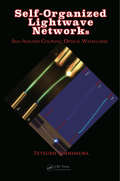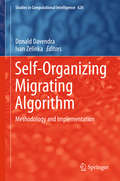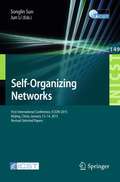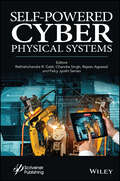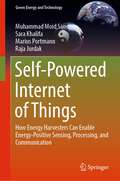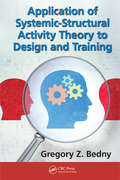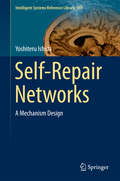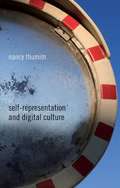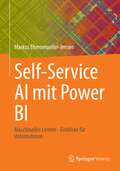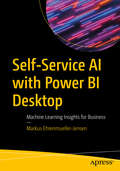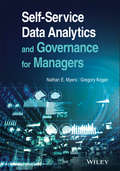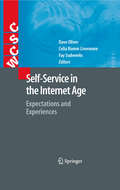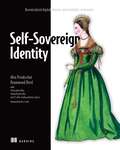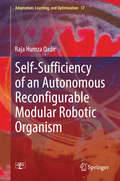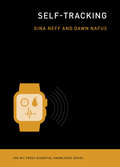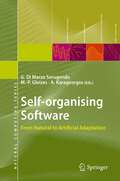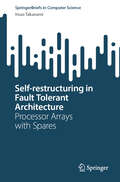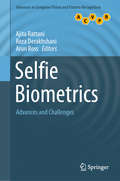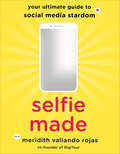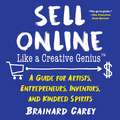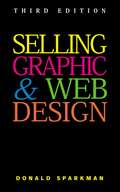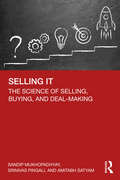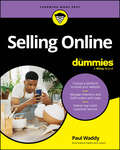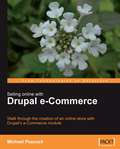- Table View
- List View
Self-Organized Lightwave Networks: Self-Aligned Coupling Optical Waveguides
by Tetsuzo YoshimuraThis book gives a solution to the problem of constructing lightwave paths in free spaces by proposing the concept of a Self-Organized Lightwave Network (SOLNET). This concept enables us to form self-aligned coupling optical waveguides automatically. SOLNETs are fabricated by self-focusing of lightwaves in photosensitive media, in which the refractive index increases upon light beam exposure, to realize the following functions: 1) Optical solder: Self-aligned optical couplings between misaligned devices with different core sizes 2) Three-dimensional optical wiring 3) Targeting lightwaves onto specific objects SOLNETs are expected to reduce the efforts to implement lightwaves into electronic systems and allow us to create new architectures, thus reducing costs and energy dissipation and improving overall system performance. SOLNETs are also expected to be applied to a wide range of fields where lightwaves are utilized, for example, solar energy conversion systems and biomedical technologies, especially photo-assisted cancer therapies. Readers will systematically learn concepts and features of SOLNETs, SOLNET performance predicted by computer simulations, experimental demonstrations for the proof of concepts, and expected applications. They will also be prepared for future challenges of the applications. This book is intended to be read by scientists, engineers, and graduate students who study advanced optoelectronic systems such as optical interconnects within computers and optical networking systems, and those who produce new ideas or strategies on lightwave-related subjects.
Self-Organizing Migrating Algorithm
by Ivan Zelinka Donald DavendraThis book brings together the current stateof-the-art research in Self Organizing Migrating Algorithm (SOMA) as a novelpopulation-based evolutionary algorithm, modeled on the predator-preyrelationship, by its leading practitioners. As the first ever book on SOMA, this book isgeared towards graduate students, academics and researchers, who are looking fora good optimization algorithm for their applications. This book presents themethodology of SOMA, covering both the real and discrete domains, and itsvarious implementations in different research areas. The easy-to-follow andimplement methodology used in the book will make it easier for a reader toimplement, modify and utilize SOMA.
Self-Organizing Networks
by Jun Li Songlin SunThis book constitutes the thoroughly refereed post-conference proceedings of the International ICST Conference on Self-Organizing Networks, ICSON 2015, held in January 2015 in Beijing, China. The 20 revised full papers presented were carefully reviewed and selected from 24 submissions and cover topics as resource allocation and management, signal processing and transmission, and multimedia service
Self-Powered Cyber Physical Systems
by Rajeev Agrawal Rathishchandra R. Gatti Felcy Jyothi Serrao Chandra SinghSELF-POWERED CYBER PHYSICAL SYSTEMS This cutting-edge new volume provides a comprehensive exploration of emerging technologies and trends in energy management, self-powered devices, and cyber-physical systems, offering valuable insights into the future of autonomous systems and addressing the urgent need for energy-efficient solutions in a world that is increasingly data-driven and sensor-rich. This book is an attempt to aim at a very futuristic vision of achieving self-powered cyber-physical systems by applying a multitude of current technologies such as ULP electronics, thin film electronics, ULP transducers, autonomous wireless sensor networks using energy harvesters at the component level and energy efficient clean energy for powering data centers and machines at the system level. This is the need of the hour for cyber-physical systems since data requires energy when it is stored, transmitted, or converted to other forms. Cyber-physical systems will become energy hungry since the industry trend is towards ubiquitous computing with massive deployment of sensors and actuators. This is evident in using blockchain technologies such as Bitcoin or running epochs for artificial intelligence (AI) applications. Hence, there is a need for research to understand energy patterns and distribution in cyber-physical systems and adopt new technologies to transcend to self-powered cyber-physical systems. This book explores the recent trends in energy management, self-powered devices, and methods in the cyber-physical world. Written and edited by a team of experts in the field, this book tackles a multitude of subjects related to cyber physical systems (CPSs), including self-powered sensory transducers, ambient energy harvesting for wireless sensor networks, actuator methods and non-contact sensing equipment for soft robots, alternative optimization strategies for DGDCs to improve task distribution and provider profits, wireless power transfer methods, machine learning algorithms for CPS and IoT applications, integration of renewables, electric vehicles (EVs), smart grids, RES micro-grid and EV systems for effective load matching, self-powered car cyber-physical systems, anonymous routing and intrusion detection systems for VANET security, data-driven pavement distress prediction methods, the impact of autonomous vehicles on industries and the auto insurance market, Intelligent transportation systems and associated security concerns, digital twin prototypes and their automotive applications, farming robotics for CPS farming, self-powered CPS in smart cities, self-powered CPS in healthcare and biomedical devices, cyber-security considerations, societal impact and ethical concerns, and advances in human-machine interfaces and explore the integration of self-powered CPS in industrial automation. Whether for the veteran engineer or student, this volume is a must-have for any library.
Self-Powered Internet of Things: How Energy Harvesters Can Enable Energy-Positive Sensing, Processing, and Communication (Green Energy and Technology)
by Raja Jurdak Marius Portmann Muhammad Moid Sandhu Sara KhalifaThis book covers cutting edge advancements on self-powered Internet of Things, where sensing devices can be energy-positive while capturing context from the physical world. It provides new mechanisms for activity recognition without the need of conventional inertial sensors, which demand significant energy during their operation and thus quickly deplete the batteries of internet-of-things (IoT) devices. The book offers new solutions by employing energy harvesters as activity sensors as well as power sources to enable the autonomous and self-powered operation of IoT devices without the need of human intervention. It provides useful content for graduate students as well as researchers to understand the nascent technologies of human activity, fitness and health monitoring using autonomous sensors. In particular, this book is very useful for people working on pervasive computing, activity recognition, wearable IoT, fitness/healthcare and autonomous systems.This book covers a broad range of topics related to self-powered activity recognition. The main topics of this book include wearables, IoT, energy harvesting, energy harvesters as sensors, activity recognition and self-powered operation of IoT devices. This book starts with the introduction of wearable IoT devices and activity recognition and then highlights the conventional activity recognition mechanisms. After that, it describes the use of energy harvesters to power the IoT devices. Later, it explores the use of various energy harvesters as activity sensors. It also proposes the use of energy harvesters as simultaneous source of energy and context information and defines the emerging concept of energy-positive sensing compared to conventional energy-negative sensing. Finally, it explores sensor/signal fusion to enhance the performance using multiple energy harvesters and charts a way forward for future research in this area. This book covers all important and emerging topics that have significance in the design and implementation of autonomous wearable IoT devices. We believe that this book will lay the foundation for designing self-powered IoT devices which can ultimately replace the conventional wearable IoT devices which need regular recharging and replacement.
Self-Regulation in Activity Theory: Applied Work Design for Human-Computer and Human-Machine Systems (Ergonomics Design & Mgmt. Theory & Applications)
by Waldemar Karwowski Gregory Z. Bedny Inna BednyEvery complex human-machine system includes a computer as a critically important means of work. However, an operator's interaction with a computerized system cannot be reduced to only performing computer-based tasks. Today human-computer interaction (HCI) is not limited to trained software users. People of all ages use all different kinds of gadget
Self-Repair Networks
by Yoshiteru IshidaThisbook describes the struggle to introduce a mechanism that enablesnext-generation information systems to maintain themselves. Our generationobserved the birth and growth of information systems, and the Internet inparticular. Surprisingly information systems are quite different fromconventional (energy, material-intensive) artificial systems, and ratherresemble biological systems (information-intensive systems). Many artificialsystems are designed based on (Newtonian) physics assuming that every elementobeys simple and static rules; however, the experience of the Internet suggestsa different way of designing where growth cannot be controlled butself-organized with autonomous and selfish agents. This book suggests using gametheory, a mechanism design inparticular, for designing next-generation information systems which will beself-organized by collective acts with autonomous components. The challenge of mapping a probability to time appears repeatedly in many forms throughoutthis book. The book contains interdisciplinaryresearch encompassing game theory, complex systems, reliability theory andparticle physics. All devoted to its central theme: what happens ifsystems self-repair themselves?
Self-Representation and Digital Culture
by Nancy ThumimTaking a close look at ordinary people 'telling their own story', Thumim explores self-representations in contemporary digital culture in settings as diverse as reality TV, online storytelling, and oral histories displayed in museums. Now available in paperback, Self-Representation and Digital Culture addresses the institutional contexts of production, technology and form of the texts, and the point of view of those who represent themselves. This highly original research examines how contradictory and widely different politics inform and shape examples of 'speaking for oneself'. In the book, Thumim argues that analysis and theorization of the activity of self-representation is vital for media, communication and cultural studies at a time when examples, of what should now be understood as a genre, both surround us and appear, at first glance, to all be alike.
Self-Service AI mit Power BI: Maschinelles Lernen - Einblicke für Unternehmen
by Markus Ehrenmueller-JensenIn diesem Buch wird erklärt, wie Sie die in Power BI Desktop geladenen Daten durch den Zugriff auf eine Reihe von Funktionen der künstlichen Intelligenz (KI) anreichern können. Diese KI-Funktionen sind in Power BI Desktop integriert und helfen Ihnen, neue Erkenntnisse aus vorhandenen Daten zu gewinnen. Einige der Funktionen sind automatisiert und stehen Ihnen auf Knopfdruck oder durch das Schreiben von Datenanalyseausdrücken (DAX) zur Verfügung. Andere Funktionen sind durch das Schreiben von Code in den Sprachen R, Python oder M verfügbar. Dieses Buch eröffnet Ihnen die gesamte Palette der KI-Funktionen mit klaren Beispielen, die zeigen, wann sie am besten angewendet werden und wie Sie sie auf Ihre eigenen Datensätze anwenden können. Ganz gleich, ob Sie Geschäftsanwender, Analyst oder Datenwissenschaftler sind - Power BI verfügt über KI-Funktionen, die auf Sie zugeschnitten sind. In diesem Buch erfahren Sie, welche Arten von Erkenntnissen Power BI automatisch liefern kann. Sie erfahren, wie Sie die Sprachen R und Python für Statistiken integrieren und nutzen können, wie Sie beim Laden von Daten mit Cognitive Services und Azure Machine Learning Services zusammenarbeiten, wie Sie Ihre Daten durch Fragen in einfachem Englisch erkunden können ... und vieles mehr! Es gibt KI-Funktionen für die Entdeckung Ihrer Daten, die Charakterisierung unerforschter Datensätze und die Erstellung von Was-wäre-wenn-Szenarien. Es gibt viel zu mögen und von diesem Buch zu lernen, ob Sie ein Neuling in Power BI oder ein erfahrener Benutzer sind. Power BI Desktop ist ein frei verfügbares Tool zur Visualisierung und Analyse. Dieses Buch hilft Ihnen, das Beste aus diesem Tool herauszuholen, indem Sie einige seiner neuesten und fortschrittlichsten Funktionen nutzen. Was Sie lernen werden: - Stellen Sie Fragen in natürlicher Sprache und erhalten Sie Antworten aus Ihren Daten - Lassen Sie sich von Power BI erklären, warum sich ein bestimmter Datenpunkt von den anderen unterscheidet - Lassen Sie Power BI die wichtigsten Einflussfaktoren über Datenkategorien anzeigen - Zugriff auf die in der Azure-Cloud verfügbaren Funktionen für künstliche Intelligenz - Gehen Sie denselben Drilldown-Pfad in verschiedenen Teilen Ihrer Hierarchie - Laden Sie Visualisierungen, um Ihre Berichte intelligenter zu gestalten - Simulieren Sie Änderungen an Daten und sehen Sie sofort die Folgen - Kennen Sie Ihre Daten, noch bevor Sie Ihren ersten Bericht erstellen - Erstellen Sie neue Spalten, indem Sie Beispiele für die benötigten Daten angeben - Transformieren und visualisieren Sie Ihre Daten mit Hilfe von R- und Python-Skripten Für wen dieses Buch gedacht ist: Für den begeisterten Power BI-Anwender, der modernste Funktionen der künstlichen Intelligenz (KI) einsetzen möchte, um neue Erkenntnisse aus vorhandenen Daten zu gewinnen. Für Endanwender und IT-Fachleute, die sich nicht scheuen, in die neue Welt des maschinellen Lernens einzutauchen, und bereit sind, diesen Schritt zu tun und einen tieferen Blick in ihre Daten zu werfen. Für diejenigen, die von einfachen Berichten und Visualisierungen zu diagnostischen und prädiktiven Analysen übergehen wollen.
Self-Service AI with Power BI Desktop: Machine Learning Insights for Business
by Markus Ehrenmueller-JensenThis book explains how you can enrich the data you have loaded into Power BI Desktop by accessing a suite of Artificial Intelligence (AI) features. These AI features are built into Power BI Desktop and help you to gain new insights from existing data. Some of the features are automated and are available to you at the click of a button or through writing Data Analysis Expressions (DAX). Other features are available through writing code in either the R, Python, or M languages. This book opens up the entire suite of AI features to you with clear examples showing when they are best applied and how to invoke them on your own datasets.No matter if you are a business user, analyst, or data scientist – Power BI has AI capabilities tailored to you. This book helps you learn what types of insights Power BI is capable of delivering automatically. You will learn how to integrate and leverage the use of the R and Python languages for statistics, how to integrate with Cognitive Services and Azure Machine Learning Services when loading data, how to explore your data by asking questions in plain English ... and more! There are AI features for discovering your data, characterizing unexplored datasets, and building what-if scenarios.There’s much to like and learn from this book whether you are a newcomer to Power BI or a seasoned user. Power BI Desktop is a freely available tool for visualization and analysis. This book helps you to get the most from that tool by exploiting some of its latest and most advanced features.What You Will LearnAsk questions in natural language and get answers from your dataLet Power BI explain why a certain data point differs from the restHave Power BI show key influencers over categories of dataAccess artificial intelligence features available in the Azure cloudWalk the same drill down path in different parts of your hierarchyLoad visualizations to add smartness to your reportsSimulate changes in data and immediately see the consequencesKnow your data, even before you build your first reportCreate new columns by giving examples of the data that you needTransform and visualize your data with the help of R and Python scriptsWho This Book Is ForFor the enthusiastic Power BI user who wants to apply state-of-the-art artificial intelligence (AI) features to gain new insights from existing data. For end-users and IT professionals who are not shy of jumping into a new world of machine learning and are ready to make that step and take a deeper look into their data. For those wanting to step up their game from doing simple reporting and visualizations by making the move into diagnostic and predictive analysis.
Self-Service Data Analytics and Governance for Managers
by Nathan E. Myers Gregory KoganProject governance, investment governance, and risk governance precepts are woven together in Self-Service Data Analytics and Governance for Managers, equipping managers to structure the inevitable chaos that can result as end-users take matters into their own hands Motivated by the promise of control and efficiency benefits, the widespread adoption of data analytics tools has created a new fast-moving environment of digital transformation in the finance, accounting, and operations world, where entire functions spend their days processing in spreadsheets. With the decentralization of application development as users perform their own analysis on data sets and automate spreadsheet processing without the involvement of IT, governance must be revisited to maintain process control in the new environment. In this book, emergent technologies that have given rise to data analytics and which form the evolving backdrop for digital transformation are introduced and explained, and prominent data analytics tools and capabilities will be demonstrated based on real world scenarios. The authors will provide a much-needed process discovery methodology describing how to survey the processing landscape to identify opportunities to deploy these capabilities. Perhaps most importantly, the authors will digest the mature existing data governance, IT governance, and model governance frameworks, but demonstrate that they do not comprehensively cover the full suite of data analytics builds, leaving a considerable governance gap. This book is meant to fill the gap and provide the reader with a fit-for-purpose and actionable governance framework to protect the value created by analytics deployment at scale. Project governance, investment governance, and risk governance precepts will be woven together to equip managers to structure the inevitable chaos that can result as end-users take matters into their own hands.
Self-Service in the Internet Age
by David Oliver Celia Romm Livermore Fay SudweeksThe Internet has emerged as a network which enables a vast range of interactions between businesses and government organizations and individuals. These interactions are classified as B2C (business to consumer), B2B (business to business) and C2C (consumer to consumer) creating ever growing forms of Internet connectedness. This connectedness enables a vast range of self-service opportunities via the Internet. Self-Service in the Internet Age explores attitudes and behaviors to this new form of self-service provision. It focuses on how services are used and viewed by those who choose to use or not use them in a variety of contexts such as personal banking, shopping, travel, education, and health.
Self-Sovereign Identity: Decentralized Digital Identity And Verifiable Credentials
by Alex Preukschat Drummond ReedIn Self-Sovereign Identity: Decentralized digital identity and verifiable credentials, you&’ll learn how SSI empowers us to receive digitally-signed credentials, store them in private wallets, and securely prove our online identities.Summary In a world of changing privacy regulations, identity theft, and online anonymity, identity is a precious and complex concept. Self-Sovereign Identity (SSI) is a set of technologies that move control of digital identity from third party &“identity providers&” directly to individuals, and it promises to be one of the most important trends for the coming decades. Now in Self-Sovereign Identity, privacy and personal data experts Drummond Reed and Alex Preukschat lay out a roadmap for a future of personal sovereignty powered by the Blockchain and cryptography. Cutting through the technical jargon with dozens of practical use cases from experts across all major industries, it presents a clear and compelling argument for why SSI is a paradigm shift, and shows how you can be ready to be prepared for it. About the technology Trust on the internet is at an all-time low. Large corporations and institutions control our personal data because we&’ve never had a simple, safe, strong way to prove who we are online. Self-sovereign identity (SSI) changes all that. About the book In Self-Sovereign Identity: Decentralized digital identity and verifiable credentials, you&’ll learn how SSI empowers us to receive digitally-signed credentials, store them in private wallets, and securely prove our online identities. It combines a clear, jargon-free introduction to this blockchain-inspired paradigm shift with interesting essays written by its leading practitioners. Whether for property transfer, ebanking, frictionless travel, or personalized services, the SSI model for digital trust will reshape our collective future. What's inside The architecture of SSI software and services The technical, legal, and governance concepts behind SSI How SSI affects global business industry-by-industry Emerging standards for SSI About the reader For technology and business readers. No prior SSI, cryptography, or blockchain experience required. About the authors Drummond Reed is the Chief Trust Officer at Evernym, a technology leader in SSI. Alex Preukschat is the co-founder of SSIMeetup.org and AlianzaBlockchain.org. Table of Contents PART 1: AN INTRODUCTION TO SSI 1 Why the internet is missing an identity layer—and why SSI can finally provide one 2 The basic building blocks of SSI 3 Example scenarios showing how SSI works 4 SSI Scorecard: Major features and benefits of SSI PART 2: SSI TECHNOLOGY 5 SSI architecture: The big picture 6 Basic cryptography techniques for SSI 7 Verifiable credentials 8 Decentralized identifiers 9 Digital wallets and digital agents 10 Decentralized key management 11 SSI governance frameworks PART 3: DECENTRALIZATION AS A MODEL FOR LIFE 12 How open source software helps you control your self-sovereign identity 13 Cypherpunks: The origin of decentralization 14 Decentralized identity for a peaceful society 15 Belief systems as drivers for technology choices in decentralization 16 The origins of the SSI community 17 Identity is money PART 4: HOW SSI WILL CHANGE YOUR BUSINESS 18 Explaining the value of SSI to business 19 The Internet of Things opportunity 20 Animal care and guardianship just became crystal clear 21 Open democracy, voting, and SSI 22 Healthcare supply chain powered by SSI 23 Canada: Enabling self-sovereign identity 24 From eIDAS to SSI in the European Union
Self-Sufficiency of an Autonomous Reconfigurable Modular Robotic Organism
by Raja Humza QadirThis book describes how the principle of self-sufficiency can be applied to a reconfigurable modular robotic organism. It shows the design considerations for a novel REPLICATOR robotic platform, both hardware and software, featuring the behavioral characteristics of social insect colonies. Following a comprehensive overview of some of the bio-inspired techniques already available, and of the state-of-the-art in re-configurable modular robotic systems, the book presents a novel power management system with fault-tolerant energy sharing, as well as its implementation in the REPLICATOR robotic modules. In addition, the book discusses, for the first time, the concept of "artificial energy homeostasis" in the context of a modular robotic organism, and shows its verification on a custom-designed simulation framework in different dynamic power distribution and fault tolerance scenarios. This book offers an ideal reference guide for both hardware engineers and software developers involved in the design and implementation of autonomous robotic systems.
Self-Tracking: The Mit Press Essential Knowledge Series (The MIT Press Essential Knowledge series)
by Gina Neff Dawn NafusWhat happens when people turn their everyday experience into data: an introduction to the essential ideas and key challenges of self-tracking.People keep track. In the eighteenth century, Benjamin Franklin kept charts of time spent and virtues lived up to. Today, people use technology to self-track: hours slept, steps taken, calories consumed, medications administered. Ninety million wearable sensors were shipped in 2014 to help us gather data about our lives. This book examines how people record, analyze, and reflect on this data, looking at the tools they use and the communities they become part of. Gina Neff and Dawn Nafus describe what happens when people turn their everyday experience—in particular, health and wellness-related experience—into data, and offer an introduction to the essential ideas and key challenges of using these technologies. They consider self-tracking as a social and cultural phenomenon, describing not only the use of data as a kind of mirror of the self but also how this enables people to connect to, and learn from, others.Neff and Nafus consider what's at stake: who wants our data and why; the practices of serious self-tracking enthusiasts; the design of commercial self-tracking technology; and how self-tracking can fill gaps in the healthcare system. Today, no one can lead an entirely untracked life. Neff and Nafus show us how to use data in a way that empowers and educates.
Self-organising Software
by Marie-Pierre Gleizes Anthony Karageorgos Giovanna Di Marzo SerugendoSelf-organisation, self-regulation, self-repair and self-maintenance are promising conceptual approaches for dealing with complex distributed interactive software and information-handling systems. Self-organising applications dynamically change their functionality and structure without direct user intervention, responding to changes in requirements and the environment. This is the first book to offer an integrated view of self-organisation technologies applied to distributed systems, particularly focusing on multiagent systems. The editors developed this integrated book with three aims: to explain self-organisation concepts and principles, using clear definitions and a strong theoretical background; to examine how self-organising behaviour can be modelled, analysed and systematically engineered into agent behaviour; and to assess the types of problems that can be solved using self-organising multiagent systems. The book comprises chapters covering all three dimensions, synthesising up-to-date research work and the latest technologies and applications. The book offers dedicated chapters on concepts such as self-organisation, emergence in natural systems, software agents, stigmergy, gossip, cooperation and immune systems. The book then explains how to engineer artificial self-organising software, in particular it examines methodologies and middleware infrastructures. Finally, the book presents diverse applications of self-organising software, such as constraint satisfaction, trust management, image recognition and networking. The book will be of interest to researchers working on emergent phenomena and adaptive systems. It will also be suitable for use as a graduate textbook, with chapter summaries and exercises, and an accompanying website that includes teaching slides, exercise solutions and research project outlines. Self-organisation, self-regulation, self-repair and self-maintenance are promising conceptual approaches for dealing with complex distributed interactive software and information-handling systems. Self-organising applications dynamically change their functionality and structure without direct user intervention, responding to changes in requirements and the environment. This is the first book to offer an integrated view of self-organisation technologies applied to distributed systems, particularly focusing on multiagent systems. The editors developed this integrated book with three aims: to explain self-organisation concepts and principles, using clear definitions and a strong theoretical background; to examine how self-organising behaviour can be modelled, analysed and systematically engineered into agent behaviour; and to assess the types of problems that can be solved using self-organising multiagent systems. The book comprises chapters covering all three dimensions, synthesising up-to-date research work and the latest technologies and applications. The book offers dedicated chapters on concepts such as self-organisation, emergence in natural systems, software agents, stigmergy, gossip, cooperation and immune systems. The book then explains how to engineer artificial self-organising software, in particular it examines methodologies and middleware infrastructures. Finally, the book presents diverse applications of self-organising software, such as constraint satisfaction, trust management, image recognition and networking. The book will be of interest to researchers working on emergent phenomena and adaptive systems. It will also be suitable for use as a graduate textbook, with chapter summaries and exercises, and an accompanying website that includes teaching slides, exercise solutions and research project outlines.
Self-restructuring in Fault Tolerant Architecture: Processor Arrays with Spares (SpringerBriefs in Computer Science)
by Itsuo TakanamiRecently, high-speed and high-quality technologies for processing many kinds of information have become essential and will become more and more necessary in the future. For such needs, parallel computer systems composed of many processing elements (PEs) are used and it is important to make high reliable systems which is called "fault-tolerant computer systems". As VLSI technology has developed, the realization of parallel computer systems using multi-chip module (MCM) or wafer scale integration (WSI) has been considered so as to enhance the speed of the computers, decrease energy consumption and sizes, and so on. In such a realization, entire or significant parts of PEs and connections among them are connected or implemented on a board or wafer. Therefore, the reliability and/or yield of the system may become drastically low if there is no strategy for coping with faults or defects. In realizing such systems as well as parallel computer systems, in order to restore the correct computation capabilities of the systems with faults, it must be reconfigured appropriately using spare PEs so that the faulty PEs are eliminated from the computation paths by replacing faulty PEs with healthy spare PEs and the remaining healthy PEs maintain correct logical connectivity among them. Various strategies to reconfigure a faulty physical system into a fault-free target logical system are described in the literature. Some of these techniques employ very powerful reconfiguring systems that can repair a faulty processor array with almost certainty, even in the presence of clusters of multiple faults. However, the key limitation of these techniques is that they are executed in software programs to run on an external host computer and they cannot be designed and implemented efficiently within a system. If a faulty system can be self-reconfigured by a built-in circuit or network, the system down time is significantly reduced. Furthermore, the system will become more reliable when it is used in such environments that the fault information cannot be monitored externally and manual maintenance operations are difficult. This book concerns fault-tolerant systems consisting of many PEs, mainly mesh-connected processor arrays. A mesh-connected processor array is a kind of form of massively parallel computing systems which consist of hundreds of PEs and have regular and modular structures, small wiring length between PEs, and high scalabilities. Here, self-reconfiguration of processor systems with spares using built-in digital circuits are focused on and spare arrangements together with networks connecting among PEs and reconfiguration algorithms with digital circuits are described, considering the number of spares, reconfiguration algorithms and their hardware realizations (built-in circuits), etc. where spares are arranged on the sides or diagonal of arrays. The effectiveness of the systems is evaluated in terms of the survival rates (successfully reconfigured rates) for the number of faults, and the array reliabilities (successfully reconfigured probabilities under the condition that each PE is equally reliable).
Selfie Biometrics: Advances and Challenges (Advances in Computer Vision and Pattern Recognition)
by Ajita Rattani Reza Derakhshani Arun RossThis book highlights the field of selfie biometrics, providing a clear overview and presenting recent advances and challenges. It also discusses numerous selfie authentication techniques on mobile devices. Biometric authentication using mobile devices is becoming a convenient and important means of verifying identity for secured access and services such as telebanking and electronic transactions. In this context, face and ocular biometrics in the visible spectrum has gained increased attention from the research community. However, device mobility and operation in uncontrolled environments mean that facial and ocular images captured with mobile devices exhibit substantial degradation as a result of adverse lighting conditions, specular reflections and motion and defocus blur. In addition, low spatial resolution and the small sensor of front-facing mobile cameras further degrade the sample quality, reducing the recognition accuracy of face and ocular recognition technology when integrated into smartphones. Presenting the state of the art in mobile biometric research and technology, and offering an overview of the potential problems in real-time integration of biometrics in mobile devices, this book is a valuable resource for final-year undergraduate students, postgraduate students, engineers, researchers and academics in various fields of computer engineering.
Selfie Made: Your Ultimate Guide to Social Media Stardom
by Meridith Valiando RojasHOW DO I MAKE IT BIG ON SOCIAL MEDIA? WHAT IS MY STORY—AND WHO IS MY AUDIENCE? WHAT CONTENT SHOULD I POST TO ACHIEVE #SUCCESS? HOW DO I GO VIRAL…OR HOW LONG WILL IT TAKE ME TO GET NOTICED?Selfie Made is a one-of-a-kind guide to creating a digital identity, finding an audience, and building a powerful brand—your own!—on the Internet. Whether you want to be in front of or behind the camera, produce click-worthy content or start your own business, this book is the place to begin. Written by Meridith Valiando Rojas, the hugely successful (and super friendly IRL) founder of DigiTour who has worked with every major star from YouTube to Musical.ly, this collection of personal anecdotes and professional advice, tricks of the trade and behind-the-screen secrets, will give you everything you need for your social media toolkit.Here, you’ll get to know the true stories behind some of today’s most successful multimedia stars and influencers, including:Max And Harvey - Blake Gray - Danielle CohnBryce Xavier - Lauren Godwin - Nathan TriskaTrevor Moran - Messy Monday - Simon Britton…and others who learned the ropes, beat the odds, and took social media by storm. And so can you!
Sell Online Like a Creative Genius: A Guide for Artists, Entrepreneurs, Inventors, and Kindred Spirits (Like a Creative Genius #1)
by Brainard CareyHow to sell art or anything else online without leaving your home. Whether you’re selling original artwork, jewelry, or a unique product, this is the book for you. Brainard Carey offers advice with solid examples of how building an online business is something every creative person can pursue. Carey draws from his extensive experience and interviews with others to show artists and creative people how to sell their work independently and efficiently. Readers will learn how to establish an online store, develop a presence, promote their goods, and reach customers. Chapter topics include: Designing a website or profile on an existing site Effective marketing strategies Creative ways to advertise your product Building your social media following Finding new customers Real examples of artists and entrepreneurs who succeeded in selling their work online And much more With chapters divided between practical how-tos and case studies, Sell Online Like a Creative Genius™, offers readers both instructive and demonstrative lessons in making their small online business a reality. Everyone can do it with the right tools, and Carey offers an insider’s guide to an otherwise daunting process.
Selling Graphic and Web Design
by Donald SparkmanExpert guidance on selling graphic design, in print and online. Attract today's savvy design clients! A veteran designer who turned his small business into a multimillion-dollar new-media company shares his strategies for success in this new edition of the acclaimed Selling Graphic and Web Design. Donald Sparkman's approach blurs the lines between graphic design, web design, and marketing by building strategic partnerships and thinking outside the box. No-nonsense advice for writing proposals and offering the right design solutions, plus information on providing services that fit a client's needs and budget, have made this book indispensable. Now, in this revised and expanded version, leading Internet designers share strategies on effective marketing for the web, including pricing, billing, portfolios, ethics, brand design, web content management, brand law, and much more. Trusted advice and the latest strategies combine to make Selling Graphic and Web Design a great one-stop resource for designers in every field. New edition of a classic Up-to-the-minute advice on selling to internet clients Get the top clients and keep them
Selling IT: The Science of Selling, Buying, and Deal-Making
by Amitabh Satyam Sandip Mukhopadhyay Srinivas PingaliInformation technology (IT) is an essential core of the economy today. Corporations and governments worldwide rely on it to drive their core strategy and develop and execute business models. Amounting to over 3.7 trillion US dollars of worldwide spending, the growing significance of the IT industry in the global economy is now well established. Hence, it is crucial to understand the marketplace within which it exists, and this book presents a systematic analysis of the processes, techniques, and methods involved in IT sales and marketing. In Selling IT, the book: Integrates a large IT provider’s selling process with the enterprise user’s IT buying process to highlight the nuances of selling, marketing, and developing IT solutions that create value for customers. Discusses various key concepts such as value-based IT selling, business case for IT acquisition, vendor evaluation and management, account and customer relationship management, customer segmentation, and techniques for customer acquisition and retention. Analyses the challenges and opportunities involved in selling digital IT and examines the evolution of jobs and careers based on the changed IT landscape. Includes lesson plans, case studies, and chapter-wise practice questions to support teaching and learning. The book boasts a robust theoretical foundation supported by a clear exposition of concepts and management theories. It will be of benefit to professionals using organisation-mandated selling processes. Young executives with a technology background looking for a sales and marketing career in the IT industry can also effectively use this book. It will also be an essential read for scholars and researchers in B2B marketing, IT consulting, technology sales, and digital transformation.
Selling Online For Dummies
by Paul WaddyTransform your ecommerce ideas into profitable reality with this page-turning new handbook Online shopping is more popular than ever, and ecommerce is now a multi-billion-dollar industry. Isn’t it time for you to claim your share? If you’ve been wondering how to start an online business, or get your current business thriving online, this comprehensive guide shares everything you need to know. In Selling Online For Dummies, ecommerce advisor and online shopping guru Paul Waddy shows you exactly how to get started in setting up your online shop. With an expert’s eye for business, and an easy-to-understand take on the technical stuff, Waddy takes you from digital start to finish as he discusses topics like: Finding hot products to sell, working with suppliers and managing your inventory Building a website from scratch by choosing the right developer and platform Marketing your site with smart SEO, paid ads, and organic marketing strategies on Google, Instagram, Facebook and TikTok Understanding the user experience and creating happy, loyal customers Dealing with payments, currencies, taxes and duties It’s time to take advantage of the commercial opportunities waiting for you online. Selling Online For Dummies is a must-read that will help you turn your great idea from virtual to reality.
Selling Online with Drupal e-Commerce
by Michael PeacockThe book starts with the basics of Drupal and then steps you through the creation of an online shop, exploring Drupal further as needed. Only the features of Drupal relevant to the e-commerce application will be covered. Written in a straightforward, easy-to-understand manner, the book provides the essentials of getting your e-commerce website up and running with Drupal. This book is for people who want to start selling online as quickly as possible, and want to see how to use the proven Drupal platform to achieve this. The book is ideal for use in a small business with only basic in-house technical skills. It will also be useful for developers who not only want to create an e-commerce site, but also want a CMS platform for expanding the site in the future. No prior knowledge of Drupal is required. No PHP experience is expected, although it will be useful. Basic knowledge of e-commerce will also be useful, although the main concepts are introduced and covered as required.
Selling Used Books Online: The Complete Guide to Bookselling at Amazon's Marketplace and Other Online Sites
by Stephen Windwalker Genevieve KazdinDiscusses how to get started selling used books online, with an emphasis on amazon.com. Also covers the basics of starting and running a business.
